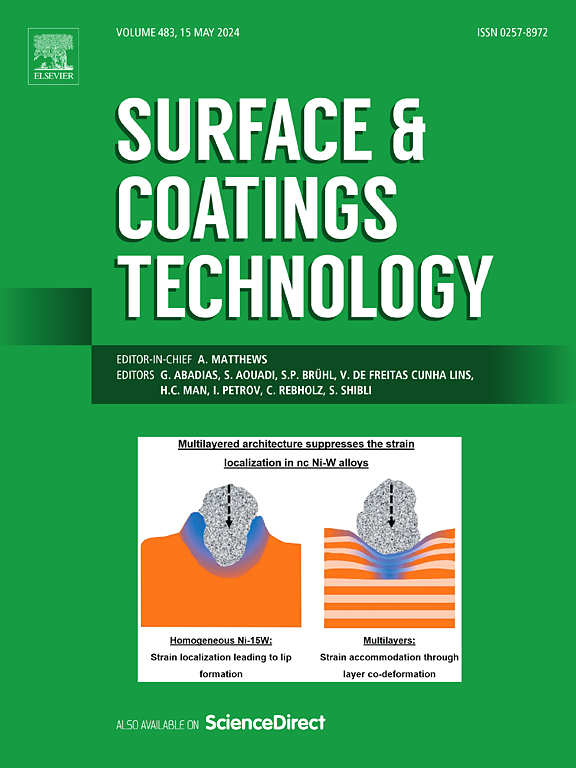激光熔覆钼合金钨铬钴合金涂层对SS304表面高温耐磨性的增强
IF 6.1
2区 材料科学
Q1 MATERIALS SCIENCE, COATINGS & FILMS
引用次数: 0
摘要
严重的磨损通常会限制SS304组件的高温耐久性,因此需要开发表面工程解决方案。在这项研究中,使用激光定向能沉积(L-DED)开发了mo增强的钨铬钴合金6包层,以提供增强的表面保护。与SS304基体相比,添加(3、6和9 wt%) Mo增强层的硬度分别提高了2.9倍、3.1倍和3.3倍。这种改善归因于mo诱导的固溶体强化和硬金属间相的形成。在(10和20 N)载荷下,在室温和600℃下进行干滑动磨损试验。使用OM, XRD, FE-SEM, EDX和拉曼光谱对包层进行了磨损表征。在高温下,包层主要表现为磨粒磨损和轻微的塑性变形。然而,在600℃时,磨损机制演变为严重的粘合、氧化、磨粒和塑性变形模式的组合,其中氧化磨损控制着摩擦学行为。由于形成了Cr2O3、NiO、CoO2和Co3O4氧化釉层,Mo含量为9wt %的钨铬钴合金6具有较好的摩擦学性能。熔覆层性能的增强得益于固溶强化、富cr碳化物形成、位错密度的增加以及L-DED技术的细化组织和强冶金结合。这些发现突出了mo增强Stellite 6 L-DED包层在高温磨损应用中的进一步发展潜力。本文章由计算机程序翻译,如有差异,请以英文原文为准。

Surface enhancement of SS304 for high-temperature wear resistance using laser cladded Mo-alloyed stellite 6 coatings
Severe wear often limits the high-temperature durability of SS304 components, necessitating the development of surface-engineered solutions. In this investigation, Mo-reinforced Stellite 6 claddings were developed using Laser Directed Energy Deposition (L-DED) to provide enhanced surface protection. Claddings with (3, 6, and 9 wt%) Mo reinforcement enhanced hardness by 2.9, 3.1, and 3.3 times, respectively, compared to the SS304 substrate. This improvement is attributed to Mo-induced solid solution strengthening and the formation of hard intermetallic phases. Dry sliding wear tests were conducted at RT and 600 °C under (10 and 20 N) loads. Wear characterisation of the clads was performed using OM, XRD, FE-SEM, EDX, and Raman spectroscopy. At RT, claddings primarily exhibited abrasive wear with minor plastic deformation. However, at 600 °C, the wear mechanism evolved into a combination of severe adhesive, oxidative, abrasive, and plastic deformation modes, with oxidative wear governing the tribological behavior. Stellite 6 with 9 wt% Mo clads exhibited better tribological performance than the other two variants, owing to the development of oxide glaze layers of Cr2O3, NiO, CoO2, and Co3O4. Enhanced performance of the claddings is attributed to solid solution strengthening, Cr-rich carbide formation, increased dislocation density, and the L-DED technology enabling refined microstructure and strong metallurgical bonding. These findings highlight the potential for further advancements in Mo-reinforced Stellite 6 L-DED claddings for high-temperature wear applications.
求助全文
通过发布文献求助,成功后即可免费获取论文全文。
去求助
来源期刊

Surface & Coatings Technology
工程技术-材料科学:膜
CiteScore
10.00
自引率
11.10%
发文量
921
审稿时长
19 days
期刊介绍:
Surface and Coatings Technology is an international archival journal publishing scientific papers on significant developments in surface and interface engineering to modify and improve the surface properties of materials for protection in demanding contact conditions or aggressive environments, or for enhanced functional performance. Contributions range from original scientific articles concerned with fundamental and applied aspects of research or direct applications of metallic, inorganic, organic and composite coatings, to invited reviews of current technology in specific areas. Papers submitted to this journal are expected to be in line with the following aspects in processes, and properties/performance:
A. Processes: Physical and chemical vapour deposition techniques, thermal and plasma spraying, surface modification by directed energy techniques such as ion, electron and laser beams, thermo-chemical treatment, wet chemical and electrochemical processes such as plating, sol-gel coating, anodization, plasma electrolytic oxidation, etc., but excluding painting.
B. Properties/performance: friction performance, wear resistance (e.g., abrasion, erosion, fretting, etc), corrosion and oxidation resistance, thermal protection, diffusion resistance, hydrophilicity/hydrophobicity, and properties relevant to smart materials behaviour and enhanced multifunctional performance for environmental, energy and medical applications, but excluding device aspects.
 求助内容:
求助内容: 应助结果提醒方式:
应助结果提醒方式:


